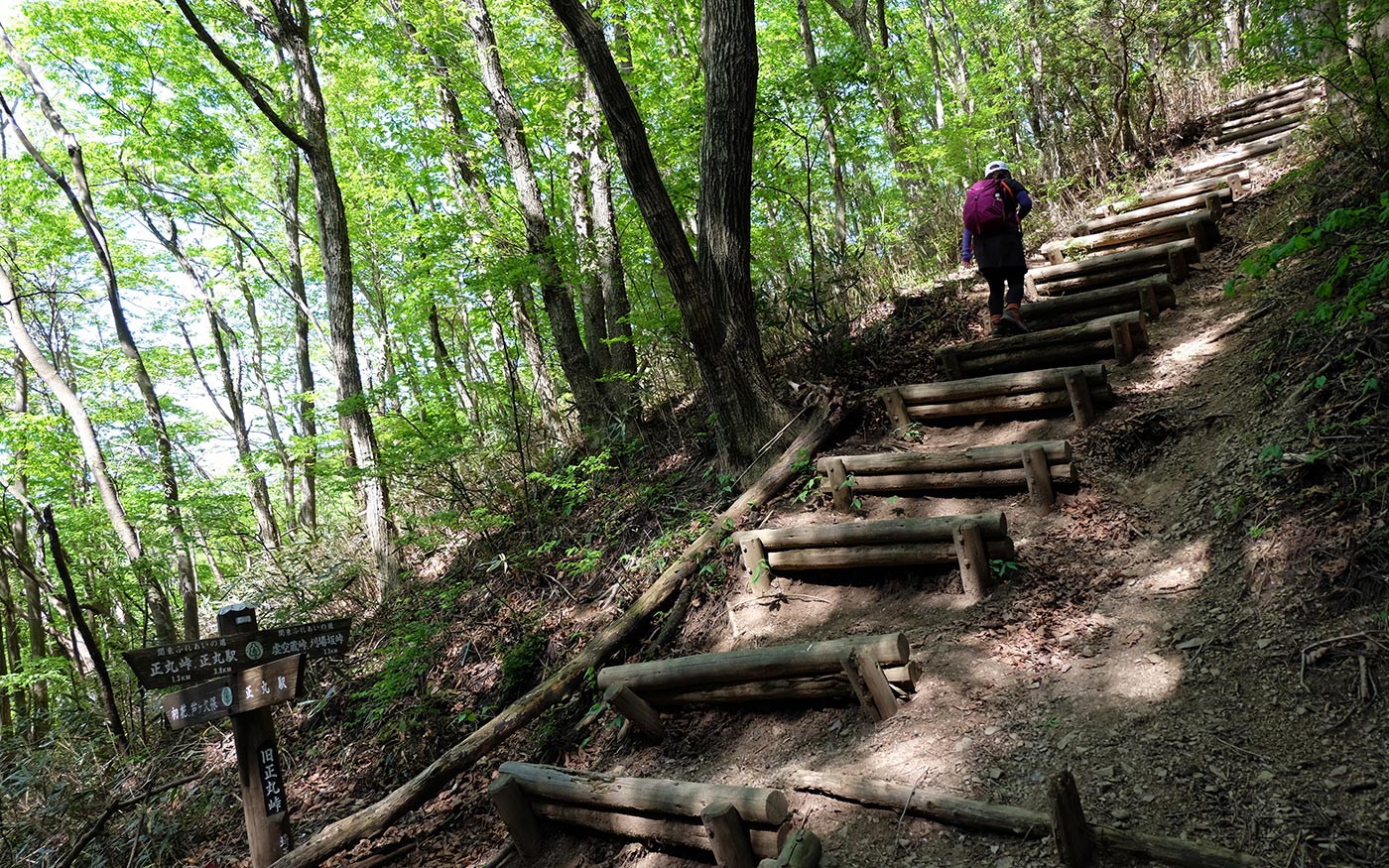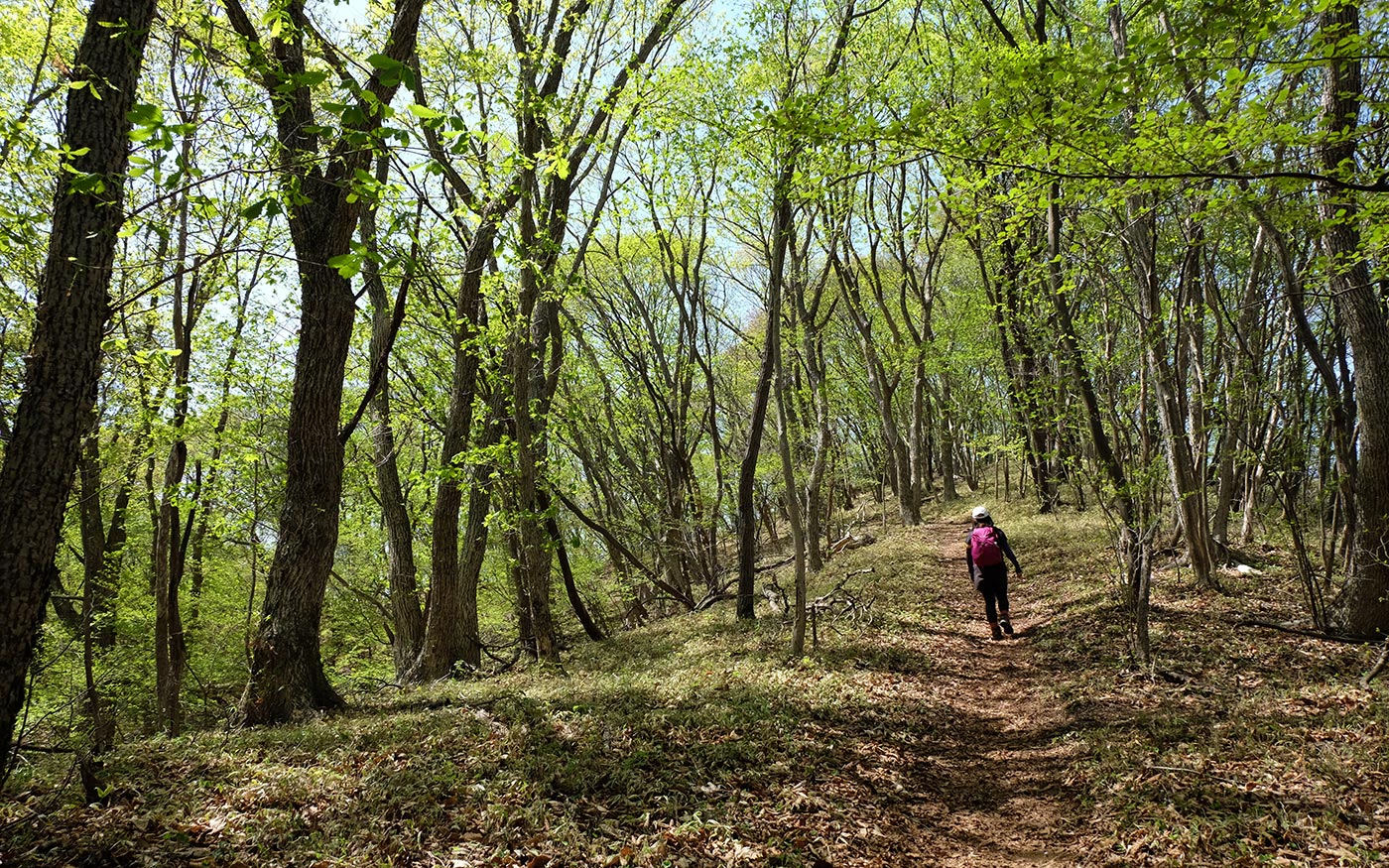8. Old Shomaru Pass and Mt. Kaba Trail (旧正丸峠・カバ岳トレイル)
Trail Location: Start: Shomaru station, Seibu Chichibu line
Goal: Ashibakuboe station, Seibu Chichibu line
Access From Tokyo, take an express train or a limited express train on the Seibu Ikebukuro line at Ikebukuro to Hanno. From there, take the Seibu Chichibu line to Shomaru station. The trip takes 80 to 90 minutes.
To return to Tokyo, take the Seibu Chichibu line at Ashigakubo station to Hannno station. From there, take the Seibu Ikebukuro line to Ikebukuro station.
Total Length: 13.1km
Course Time: 5 hours 45 minutes
Elevation Difference: 590m
Difficulty Rating: 3 (moderate)
Difficulty ratings: (1) beginner, (2) easy, (3) moderate, (4) strenuous

Trail Features
・Since the old days, the silkworm-raising was a main industry in Chichibu area. In the Edo period (1603?1867), many factories were set up to produce silk textiles which were transported to Edo (present Tokyo) by Agano Route running from Hanno through Chichibu. Also in the Edo period, pilgrimage to 34 temples in Chichibu became popular and many people from Edo took Agano Route for visiting those temples. The route introduced here is a part of it.
・The trail is also a part of Kanto Fureai Trail (Kanto Region Natural Trail) stretching for 1,800 km around the Kanto area. A large number of routes are laid out to cover natural scenery and pastoral landscapes, as well as cultural and historical sites.
・For those hikers expecting panoramic views from mountaintop, going a bit further to Mt. Maruyama is highly recommended. You can expect a 360-degree view of the surrounding mountains. On clear days, the mountain ranges of Northern Alps and Southern Alps will come into view.
Trail Description
To Old Shomaru Pass
Hikers should make a left turn in front of Shomaru station and walk along Route 299 for about 250 meters. Then, take a path by the road that leads you down to a country road. There is a direction sign mounted on a telephone pole at the fork. The country road runs through a small village and passes a small shrine with a stone torii gate and a stone lantern. It will soon turn into a trail that runs along a stream. The trail crosses a stream for a couple of times and ascends along a stream before it hits a road. Fork left, walk the road for 100 meters, and enter the trail on the right. After crossing a stream and a couple of switchbacks along the slope, you will reach Old Shomaru Pass. There are no structures out there except a direction sign indicating that this spot is a junction.
To Kokuzo Pass
Fork right at the junction of Old Shomaru Pass to continue on to Kokuzo Pass. Starting with climbing steps, the trail then runs along mountain ridges of many ups and downs. Halfway down, there are steep steps of wooden poles. Then the trail veers at right angle to the left just before meeting a road at Kokuzo Pass. You can find a Kokuzo statue enshrined around the pass.
Kokuzo is one of the great bodhisattvas who is said to have boundless wisdom. The reason why a Kokuzo bodhisattva has been enshrined here is unknown. Since it is closely related to Kukai, the founder of Shingon sect of esoteric Buddhism, pilgrims to Chichibu, who were followers of Kukai, might have enshrined it here.

To Ohono Pass via Ushidatenokubo
There is a shelter at the corner of Kokuzo Pass. Turn left at the junction and proceed a road for 300 meters before entering a trail on the left. There is a direction sign where the trail branches off the road, though it only mentions “Kokuzo Pass ? Karibazaka Pass” where the road leads to. From Kokuzo Pass, you will arrive at Ushidatenokubo in half an hour. At the junction of Ushidatenokubo, turn left to head for Mt. Kaba and onto Ohno Pass.

The trails to Mt. Kaba and Ohno Pass run along, and meet a couple of times, Okumusashi Green Line forest road. Most of the way, the trails run on level terrain, so you can enjoy a comfortable hike. Just before arriving at the peak of Mt. Kaba, the terrain turns into a rugged one for 50 meters. Mt. Kaba, a small peak recognized only by a signpost, is surrounded by Japanese cypress trees and konara oak trees while “kaba” literally means birch trees. As they grow in the northern part of Japan, there are not any around here. The name might have come from “a cutting place” (苅場kaba or kariba) of straws for thatched roofs used back in the old days.
Past Mt. Kaba, the trail descends gently and soon meets a road. After 20 meters, you will enter a trail again and soon arrive at Ohno Pass. For those hikers expecting panoramic views from mountaintop, going a bit further to Mt. Maruyama should be nice. Proceed a trail beside a shelter. A round trip between here and Mt. Maruyama will take about an hour.
To Ashigakubo station
Ohno Pass is a junction of three roads. Enter a trail at the opposite side of a shelter to proceed southwest to Ashigakubo station. After a steep descent for a while, the trail comes to run along a stream. The slope soon becomes shallower and the trail skirts around the mountain. Then it comes to a small village and meets Route 299. Proceed the sidewalk on the right hand side of the road. There is a stone Jizo statue housed in a shelter down the road. Ashigakubo station is 2 km away along the road.
Translator: Shuji Ozaki Author: Toru Sasaki
